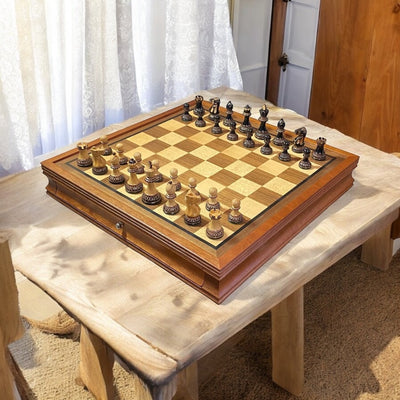Who Invented Chess?
We felt it was time to look back at the history of chess, especially after the success of The Queen's Gambit. Chess is one the most complex games. The current version, which we all love, was first introduced in Europe in the second quarter of the 15th century. However, there have been similar and influential games for hundreds of years. Below, we'll cover all that.
The Origins of Chess
Chaturanga, the earliest form of chess, was known as Chaturanga. It is believed that it originated in Northwest India around 7th century. This is approximately 1,400 years ago. Chaturanga, Sanskrit for “Four Divisions,” refers to the infantry and cavalry of elephants and elephants. These would later evolve into modern chess' knight, pawn, rook, and bishop. The game was spread from India to Persia by the Arabs, who then conquered Persia.
Fun fact about "Checkmate": When the game was first developed in Persia players would shout "Shah!" to attack the king. This is Persian for "King!" Later, they started to say "Shah Mat!" which means "the king's helpless!"
Simultaneously similar versions of the game were being developed in China. This was also due to India's Chaturanga influence. The Chinese game, xiangqi uses similar objectives but the board placement is different. Xiangqi was also inspired in part by Go, a Chinese game that dates back to the 6th Century. This game is still being played competitively today.
By the 9th century, chess had reached Western Europe and Russia. A Medieval Latin poem titled "Versus scachis" dates back to approximately 1,000 AD. It is often considered to be the first European reference for chess. However, the modern form of the game didn't appear until a few centuries after. The game had become a very similar to modern chess by the 15th century thanks to Christian prohibitions and other regulations.
The short answer is: The short answer is that Chess and many other variants of modern Chess were inspired by Chaturanga, an Indian game. It dates back to 6 centuries ago.
The World Chess Championships
We need to move forward. Romantic Chess was dominant from the 15th century until the end of the 19th century. It emphasized quick-paced tactical maneuvers over long-term strategic play (from David Shenk’s The Importal Game: A History of Chess). The modern era of chess began in the second half of 19th century. 1886 was the year that saw the inaugural World Chess Championship.
From 1886 to 1894, Wilhelm Steinitz (later American) was the first World Chess Champion. Steinitz's game changed significantly throughout his career. He started out aggressively but eventually became a more positional player. This was controversial at the time. 1886 sparked a frenzy in chess theory. This allowed the game to evolve into something closer to the modern era. Steinitz lost his title to German Emanuel Lasker in 1894. Lasker was the champion for 27 years from 1894 until 1921. He remains the longest-reigning champion in history.
In Paris, the FIDE (World Chess Federation), was established in 1924. It initiated the practice to award titles such as Grandmasters to elite players. Although some claim that Grandmasters were created in the 20th Century, these claims are not supported.
Modern Day Chess
The Soviet Union ruled the chess world indefinitely after World War II. Bobby Fischer, an American chess player who was champion from 1972 to 1975 was the only non-Soviet champion. He is widely considered one of the most important players of all times. The rise of Garry Kasparov, the Russian chess player who is perhaps the most famous and respected in history, was witnessed in 1985.
The second half of the 20th Century saw the rise of chess analysis and computers. In 1997, a computer defeated Garry Kasparov, a world champion in chess. This was in the famous matchup between IBM's Deep Blue (IBM) and Garry Kasparov (Garry Kasparov). This moment marked the dawn of computer dominance in the world of Chess. Since then, chess analysis and theory have improved dramatically.
The Norweigan Magnus Carlsen is the current world champion and the most dominant player in the 21st Century. Carlsen, who was a grandmaster at the age of 13, and a World Champion at 22, is undoubtedly one of the most important players in history. With 2882, he holds the highest peak Elo rating and is the Champion since 2013.
Apart from Carlsen's, 2010s saw a re-emergence in chess culture at a global level. Internationally-respected celebrities like Garry Kasparov and films like Pawn Sacrifice, as well as shows like The Queen's Gambit and Pawn Sacrifice have brought chess back to the forefront.
While the Queen's Gambit is clearly one of the main reasons, the rise in popularity of chess streamers on Twitch, such as Grandmaster Hikaru has added to the game's popularity in modern culture. Maurice Ashley and other beloved Grandmasters are now cultural icons. They have merchandise lines and catchphrases, as well as more monetization opportunities. It is only natural that the popularity of esports will continue to grow. This will mean that chess viewers and chess viewing will also increase. If you want to learn more about the game, check out GM Hikaru’s channel and all of the amazing chess streamers that the platform has to offer.









